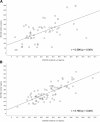Vitamin D plasma concentrations in pregnant women and their preterm newborns
- PMID: 30348112
- PMCID: PMC6198501
- DOI: 10.1186/s12884-018-2045-1
Vitamin D plasma concentrations in pregnant women and their preterm newborns
Abstract
Background: Vitamin D deficiency is a global public health issue. More than half of pregnant women are affected by vitamin D insufficiency/deficiency. Studies suggest an association between low vitamin D concentrations during pregnancy with intrauterine growth restriction and prematurity. This study aimed to describe the concentrations of 25(OH)D (25-hydroxyvitamin D) of mothers who delivered preterm newborns compared to women with full-term pregnancy deliveries, as well as to relate 25(OH)D blood concentrations of mothers with those of their newborns.
Method: This cross-sectional study was conducted with 66 mothers who had given birth to preterm babies and their preterm newborns (PTNB, < 32 weeks), and 92 women who had given birth at the full-term of their pregnancy and their newborns (FTNB). Data were collected on the characteristics of mothers (gestational age, diseases, and habits) and newborns (anthropometry and adequacy for gestational age). Ten milliliters of blood were drawn from the mothers and the umbilical cord of newborns at birth to identify the 25(OH)D, parathyroid hormone, calcium, phosphorus, and alkaline phosphatase concentrations.
Results: Mothers in the PTNB group had significantly lower mean 25(OH)D blood levels (21.7 ± 10.8 ng/mL vs. 26.2 ± 9.8 ng/mL; p = 0.011) and were three times more likely to have insufficiency when compared to mothers in the FTNB group (OR = 2.993; 95%CI 1.02-8.74). Newborns in the PTNB group also had lower 25(OH)D concentrations compared to FTNB group (25.9 ± 13.9 ng/dL vs. 31.9 ± 12.3 ng/dL; p = 0.009). There was a directly proportional correlation between mother and newborn umbilical cord 25(OH)D concentrations in PTNB (r = 0.596; p < 0.001) and FTNB (r = 0.765; p < 0.001).
Conclusion: Mothers who delivered preterm babies and their preterm newborns had lower 25(OH)D concentrations compared to women who had given birth at the full-term of their pregnancy. In both groups, 25(OH)D concentrations of the mothers correlated directly with those of the newborns, and this correlation was higher in the full-term birth group. Nevertheless, the recommended universal vitamin D supplementation in pregnant women to curb the risk of preterm birth is still incipient. More studies are required to clarify the particularities of vitamin D metabolism further and define the adequate 25(OH)D concentrations throughout pregnancy.
Keywords: Newborns; Pregnancy; Umbilical cord; Vitamin D.
Conflict of interest statement
Ethics approval and consent to participate
The Research Ethics Committee of the ABC Faculty of Medicine approved the project under opinion N° 1.060.653, dated 13/05/2015. Mothers included in the study agreed to the procedures of the research and signed the informed consent form.
Consent for publication
Not applicable.
Competing interests
The authors declare that they have co competing interests.
Publisher’s Note
Springer Nature remains neutral with regard to jurisdictional claims in published maps and institutional affiliations.
Figures
Similar articles
-
Low vitamin D status in mother-newborn pairs in Greece.Calcif Tissue Int. 2006 Jun;78(6):337-42. doi: 10.1007/s00223-006-0007-5. Epub 2006 Jul 7. Calcif Tissue Int. 2006. PMID: 16830197
-
Higher serum alkaline phosphatase activity in infants born to vitamin D-deficient mothers.Arch Osteoporos. 2019 Oct 25;14(1):102. doi: 10.1007/s11657-019-0651-9. Arch Osteoporos. 2019. PMID: 31650259
-
Vitamin D status and adequacy of standard supplementation in preterm neonates from South India.J Pediatr Gastroenterol Nutr. 2014 May;58(5):661-5. doi: 10.1097/MPG.0000000000000296. J Pediatr Gastroenterol Nutr. 2014. PMID: 24792631
-
Does Maternal Vitamin D Deficiency Increase the Risk of Preterm Birth: A Meta-Analysis of Observational Studies.Nutrients. 2016 May 20;8(5):301. doi: 10.3390/nu8050301. Nutrients. 2016. PMID: 27213444 Free PMC article. Review.
-
Reassessing vitamin D supplementation in preterm infants: a prospective study and review of the literature.J Pediatr Endocrinol Metab. 2020 Aug 31;33(10):1273-1281. doi: 10.1515/jpem-2020-0370. J Pediatr Endocrinol Metab. 2020. PMID: 32866125 Review.
Cited by
-
Vitamin D Trajectories From Birth to Early Childhood and Elevated Systolic Blood Pressure During Childhood and Adolescence.Hypertension. 2019 Aug;74(2):421-430. doi: 10.1161/HYPERTENSIONAHA.119.13120. Epub 2019 Jul 1. Hypertension. 2019. PMID: 31256718 Free PMC article.
-
Utility of umbilical cord blood 25-hydroxyvitamin D levels for predicting bronchopulmonary dysplasia in preterm infants with very low and extremely low birth weight.Front Pediatr. 2022 Aug 4;10:956952. doi: 10.3389/fped.2022.956952. eCollection 2022. Front Pediatr. 2022. PMID: 35989993 Free PMC article.
-
Systematic review and meta-analysis of vitamin D deficiency in different pregnancy on preterm birth: Deficiency in middle pregnancy might be at risk.Medicine (Baltimore). 2021 Jun 18;100(24):e26303. doi: 10.1097/MD.0000000000026303. Medicine (Baltimore). 2021. PMID: 34128867 Free PMC article.
-
Changes in bone metabolic profile associated with pregnancy or lactation.Sci Rep. 2019 May 13;9(1):6787. doi: 10.1038/s41598-019-43049-1. Sci Rep. 2019. PMID: 31086225 Free PMC article.
-
Vitamin D Status and Pregnancy Complications: Serum 1,25-di-hydroxyl-Vitamin D and its Ratio to 25-hydroxy-Vitamin D are Superior Biomarkers than 25-hydroxy-Vitamin D.Int J Med Sci. 2020 Oct 18;17(18):3039-3048. doi: 10.7150/ijms.47807. eCollection 2020. Int J Med Sci. 2020. PMID: 33173424 Free PMC article.
References
MeSH terms
Substances
Grants and funding
LinkOut - more resources
Full Text Sources
Medical


